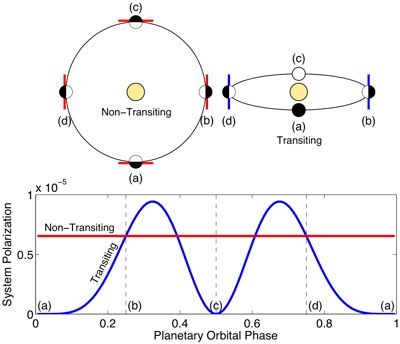Direct Detection of Exoplanets with Optical Polarimetry (3)
Orbital Inclination from Polarimetry
Regardless of orbital inclination, changes in the polarization of scattered light can be detected. Thus, changes in polarization are indicative of orbital inclination.

A featureless exoplanet in a face-on orbit always has the same intensity of scattered light, so the degree of polarization is constant throughout the orbit.
The position angle of polarization is perpendicular to the so-called “scattering plane,” which is the plane containing the light source, scatterer, and observer. This plane rotates as the exoplanet orbits, so the position angle of polarization changes throughout the orbit.
In contranst, a nearly edge-on exoplanet goes through phases like Mercury, Venus, and the Moon as seen from Earth, so the degree of polarization will change throughout the orbit (the position angle varies, but not as significantly).